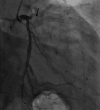Type III Kounis Syndrome Caused by Iodine Contrast Media After Improvement of Allergic Symptoms
- PMID: 38449915
- PMCID: PMC10915903
- DOI: 10.7759/cureus.55514
Type III Kounis Syndrome Caused by Iodine Contrast Media After Improvement of Allergic Symptoms
Abstract
Kounis syndrome is an acute coronary syndrome (ACS) caused by an allergic reaction that almost always occurs immediately and simultaneously with allergic symptoms. We present a case of Kounis syndrome type III that developed after complete resolution of contrast-induced anaphylaxis in a 60-year-old man with a coronary stent placed in the proximal left anterior descending (LAD) artery branch for ischemic heart disease. Contrast-enhanced computed tomography revealed anaphylactic shock. Symptoms quickly improved with intramuscular adrenaline injection; however, chest pain appeared after approximately 30 min. ECG revealed ST-wave elevation in the precordial leads. Coronary angiography revealed acute stent thrombosis with total occlusion of the proximal LAD, and percutaneous coronary angioplasty was performed. We diagnosed Kounis syndrome based on the allergic symptoms and ACS. Because some cases of Kounis syndrome develop after anaphylactic symptoms have resolved, it is advisable to follow-up patients with allergic symptoms and pay attention to chest symptoms and ECG changes, especially when they have a history of noted or treated coronary artery disease.
Keywords: allergic reaction; anaphylactic shock; anaphylax; contrast-induced anaphylaxis; extremely late stent thrombosis; iodinated contrast; iodine contrast media; kounis case study; kounis syndrome.
Copyright © 2024, Okuda et al.
Conflict of interest statement
The authors have declared that no competing interests exist.
Figures


Similar articles
-
Coronary Stent-Induced Kounis Syndrome: A Case Report.Cureus. 2025 Apr 29;17(4):e83208. doi: 10.7759/cureus.83208. eCollection 2025 Apr. Cureus. 2025. PMID: 40443635 Free PMC article.
-
From Wellens To Kounis Syndrome: An Unlucky Patient.Eur J Case Rep Intern Med. 2020 Jun 5;7(9):001689. doi: 10.12890/2020_001689. eCollection 2020. Eur J Case Rep Intern Med. 2020. PMID: 32908826 Free PMC article.
-
Insight into the Time Course of Type III Kounis Syndrome: A Case Report.J Emerg Med. 2020 Aug;59(2):e65-e68. doi: 10.1016/j.jemermed.2020.04.054. Epub 2020 Jun 11. J Emerg Med. 2020. PMID: 32536494
-
Analysis of clinical characteristics of Kounis syndrome induced by contrast media.Am J Emerg Med. 2022 Feb;52:203-207. doi: 10.1016/j.ajem.2021.12.036. Epub 2021 Dec 20. Am J Emerg Med. 2022. PMID: 34959022 Review.
-
Kounis syndrome, a disease to know: Case report and review of the literature.Monaldi Arch Chest Dis. 2018 Mar 16;88(1):898. doi: 10.4081/monaldi.2018.898. Monaldi Arch Chest Dis. 2018. PMID: 29557575 Review.
Cited by
-
Cardio-Oncoimmunology: Cardiac Toxicity, Cardiovascular Hypersensitivity, and Kounis Syndrome.Life (Basel). 2024 Mar 18;14(3):400. doi: 10.3390/life14030400. Life (Basel). 2024. PMID: 38541723 Free PMC article.
References
-
- Kounis syndrome: an update on epidemiology, pathogenesis, diagnosis and therapeutic management. Kounis NG. Clin Chem Lab Med. 2016;54:1545–1559. - PubMed
-
- A new classification of Kounis syndrome. Biteker M. Int J Cardiol. 2010;145:553. - PubMed
-
- Histamine-induced coronary artery spasm: the concept of allergic angina. Kounis NG, Zavras GM. https://pubmed.ncbi.nlm.nih.gov/1793697/ . Br J Clin Pract. 1991;45:121–128. - PubMed
Publication types
LinkOut - more resources
Full Text Sources
